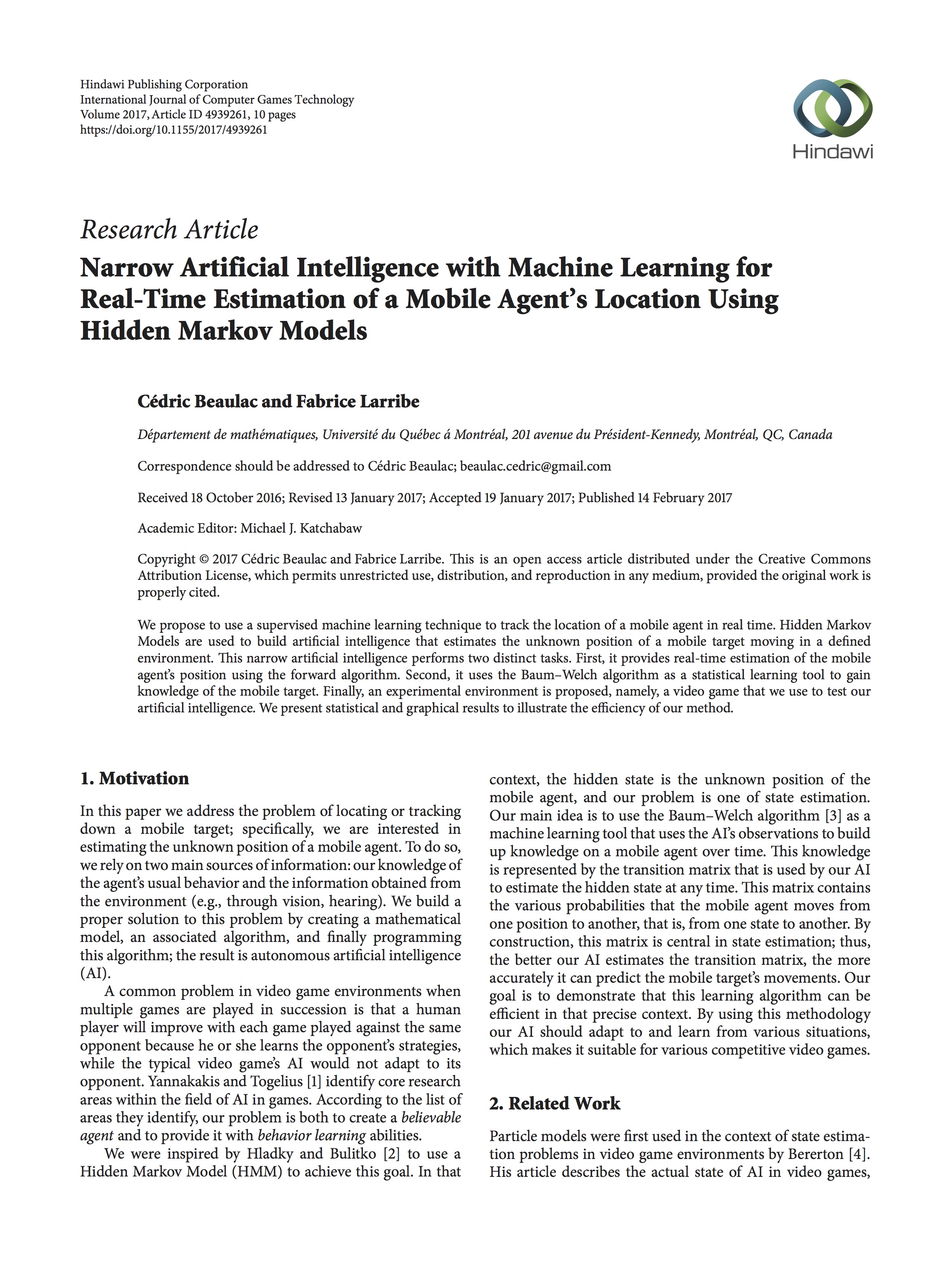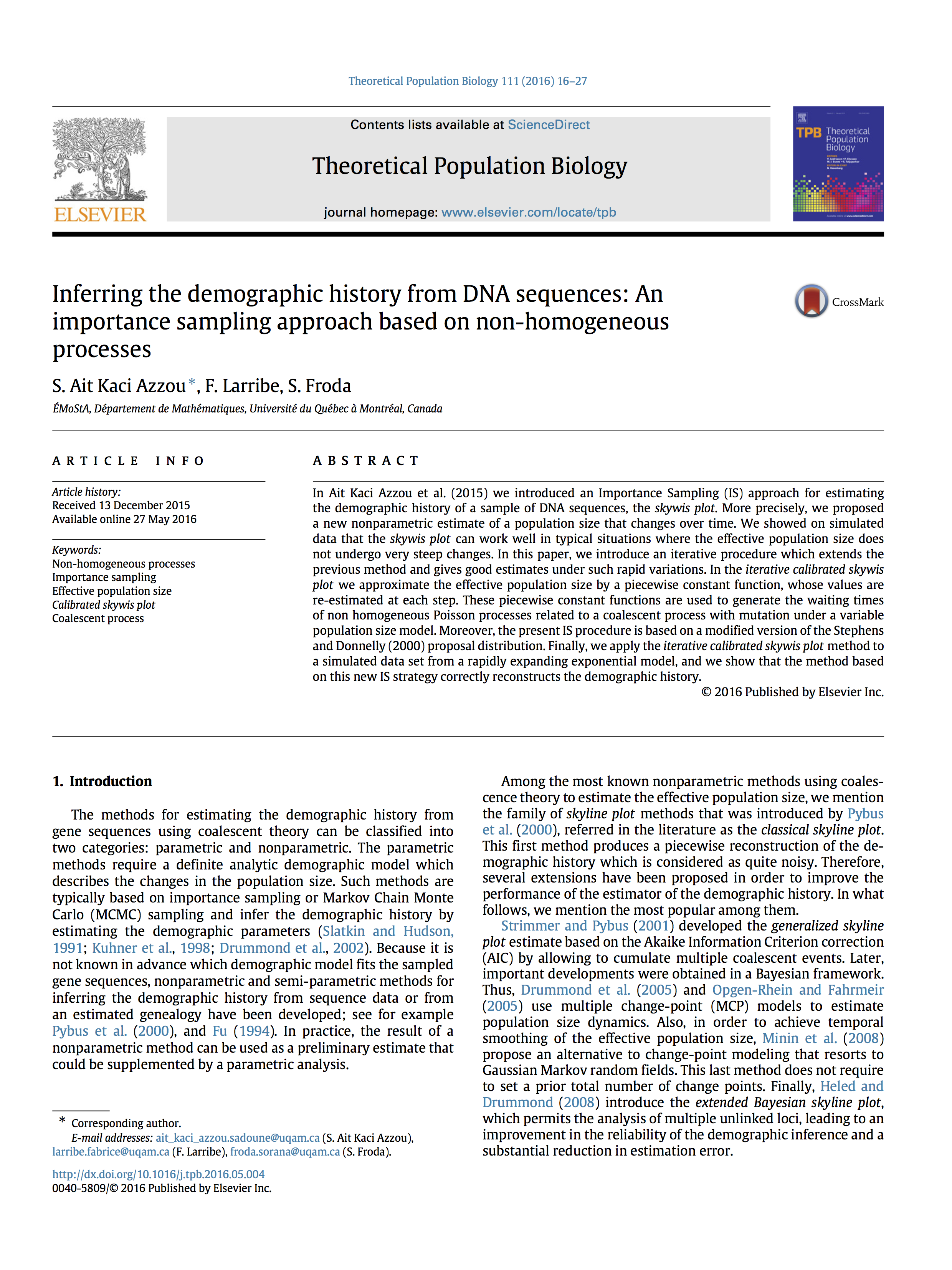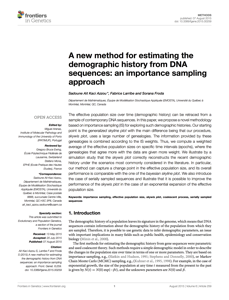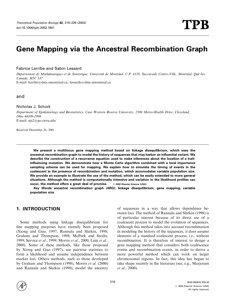- C. Beaulac and F. Larribe.
Narrow artificial intelligence with machine learning for real time estimation of a mobile agent's location using Hidden Markov Models.
International Journal of Computer Games Technology. Volume 2017 (February 2017), Article ID 4939261.

 We propose to use a supervised machine learning technique to track the location of a mobile agent in real time. Hidden Markov Models are used to build artificial intelligence that estimates the unknown position of a mobile target moving in a defined environment. This narrow artificial intelligence performs two distinct tasks. First, it provides real-time estimation of the mobile agent’s position using the forward algorithm. Second, it uses the Baum–Welch algorithm as a statistical learning tool to gain knowledge of the mobile target. Finally, an experimental environment is proposed, namely, a video game that we use to test our artificial intelligence. We present statistical and graphical results to illustrate the efficiency of our method.
We propose to use a supervised machine learning technique to track the location of a mobile agent in real time. Hidden Markov Models are used to build artificial intelligence that estimates the unknown position of a mobile target moving in a defined environment. This narrow artificial intelligence performs two distinct tasks. First, it provides real-time estimation of the mobile agent’s position using the forward algorithm. Second, it uses the Baum–Welch algorithm as a statistical learning tool to gain knowledge of the mobile target. Finally, an experimental environment is proposed, namely, a video game that we use to test our artificial intelligence. We present statistical and graphical results to illustrate the efficiency of our method.
- S. Ait Kaci Azzou, F. Larribe and S. Froda.
Inferring the demographic history from DNA sequences: an importance sampling approach based on non-homogenous processes.
Theoretical Population Biology, Volume 111, October 2016, Pages 16–27.
 In Ait Kaci Azzou et al. (2015) we introduced an Importance Sampling (IS) approach for estimating the demographic history of a sample of DNA sequences, the skywis plot. More precisely, we proposed a new nonparametric estimate of a population size that changes over time. We showed on simulated data that the skywis plot can work well in typical situations where the effective population size does not undergo very steep changes. In this paper, we introduce an iterative procedure which extends the previous method and gives good estimates under such rapid variations. In the iterative calibrated skywis plot we approximate the effective population size by a piecewise constant function, whose values are re-estimated at each step. These piecewise constant functions are used to generate the waiting times of non homogeneous Poisson processes related to a coalescent process with mutation under a variable population size model. Moreover, the present IS procedure is based on a modified version of the Stephens and Donnelly (2000) proposal distribution. Finally, we apply the iterative calibrated skywis plot method to a simulated data set from a rapidly expanding exponential model, and we show that the method based on this new IS strategy correctly reconstructs the demographic history.
In Ait Kaci Azzou et al. (2015) we introduced an Importance Sampling (IS) approach for estimating the demographic history of a sample of DNA sequences, the skywis plot. More precisely, we proposed a new nonparametric estimate of a population size that changes over time. We showed on simulated data that the skywis plot can work well in typical situations where the effective population size does not undergo very steep changes. In this paper, we introduce an iterative procedure which extends the previous method and gives good estimates under such rapid variations. In the iterative calibrated skywis plot we approximate the effective population size by a piecewise constant function, whose values are re-estimated at each step. These piecewise constant functions are used to generate the waiting times of non homogeneous Poisson processes related to a coalescent process with mutation under a variable population size model. Moreover, the present IS procedure is based on a modified version of the Stephens and Donnelly (2000) proposal distribution. Finally, we apply the iterative calibrated skywis plot method to a simulated data set from a rapidly expanding exponential model, and we show that the method based on this new IS strategy correctly reconstructs the demographic history. - F. Larribe, M.J. Dupont and G. Boucher.
Simultaneous inference of haplotypes and alleles at a causal gene.
Statistical genetics and methodology, Volume 6, Article 291, October 2015.
 We present a methodology which jointly infers haplotypes and the causal alleles at a gene influencing a given trait. Often in human genetic studies, the available data consists of genotypes (series of genetic markers along the chromosomes) and a phenotype. However, for many genetic analyses, one needs haplotypes instead of genotypes. Our methodology is not only able to estimate haplotypes conditionally on the disease status, but is also able to infer the alleles at the unknown disease locus. Some applications of our methodology are in genetic mapping and in genetic counseling.
We present a methodology which jointly infers haplotypes and the causal alleles at a gene influencing a given trait. Often in human genetic studies, the available data consists of genotypes (series of genetic markers along the chromosomes) and a phenotype. However, for many genetic analyses, one needs haplotypes instead of genotypes. Our methodology is not only able to estimate haplotypes conditionally on the disease status, but is also able to infer the alleles at the unknown disease locus. Some applications of our methodology are in genetic mapping and in genetic counseling. - S. Ait Kaci Azzou, F. Larribe and S. Froda.
A new method for estimating the demographic history from DNA sequences: an importance sampling approach.
Evolutionary and population genetics, Volume 6, Article 259, August 2015.
 The effective population size over time (demographic history) can be retraced from a sample of contemporary DNA sequences. In this paper, we propose a novel methodology based on importance sampling (IS) for exploring such demographic histories. Our starting point is the generalized skyline plot with the main difference being that our procedure, skywis plot, uses a large number of genealogies. The information provided by these genealogies is combined according to the IS weights. Thus, we compute a weighted average of the effective population sizes on specific time intervals (epochs), where the genealogies that agree more with the data are given more weight. We illustrate by a simulation study that the skywis plot correctly reconstructs the recent demographic history under the scenarios most commonly considered in the literature. In particular, our method can capture a change point in the effective population size, and its overall performance is comparable with the one of the bayesian skyline plot. We also introduce the case of serially sampled sequences and illustrate that it is possible to improve the performance of the skywis plot in the case of an exponential expansion of the effective population size.
The effective population size over time (demographic history) can be retraced from a sample of contemporary DNA sequences. In this paper, we propose a novel methodology based on importance sampling (IS) for exploring such demographic histories. Our starting point is the generalized skyline plot with the main difference being that our procedure, skywis plot, uses a large number of genealogies. The information provided by these genealogies is combined according to the IS weights. Thus, we compute a weighted average of the effective population sizes on specific time intervals (epochs), where the genealogies that agree more with the data are given more weight. We illustrate by a simulation study that the skywis plot correctly reconstructs the recent demographic history under the scenarios most commonly considered in the literature. In particular, our method can capture a change point in the effective population size, and its overall performance is comparable with the one of the bayesian skyline plot. We also introduce the case of serially sampled sequences and illustrate that it is possible to improve the performance of the skywis plot in the case of an exponential expansion of the effective population size. - F. Larribe and P. Fearnhead.
On composite likelihoods in statistical genetics.
Statistica Sinica, Volume 21 Number 1, January 2011.
[Citations de cet article]
 Due to the dimension and the dependency structure of genetic data, com- posite likelihood methods have found their natural place in the statistical methodo- logy involving such data. After a brief description of the type of data one encounters in population genetic studies, we introduce the questions of interest concerning the main genetic parameters in population genetics, and present an up to date review on how composite likelihoods have been used to estimate these parameters.
Due to the dimension and the dependency structure of genetic data, com- posite likelihood methods have found their natural place in the statistical methodo- logy involving such data. After a brief description of the type of data one encounters in population genetic studies, we introduce the questions of interest concerning the main genetic parameters in population genetics, and present an up to date review on how composite likelihoods have been used to estimate these parameters.
- F. Larribe and S. Lessard.
A Composite-Conditional-Likelihood Approach for Gene Mapping Based on Linkage Disequilibrium in Windows of Markers Loci.
Statistical Applications in Genetics and Molecular Biology. 2008: Vol. 7 : Iss. 1, Article 27.
[Citations de cet article]
 A composite-conditional-likelihood (CCL) approach is proposed to map the position of a trait-influencing mutation (TIM) using the ancestral recombination graph (ARG) and importance sampling to reconstruct the genealogy of DNA sequences with respect to windows of marker loci and predict the linkage disequilibrium pattern observed in a sample of cases and controls. The method is designed to fine-map the location of a disease mutation, not as an association study. The CCL function proposed for the position of the TIM is a weighted product of conditional likelihood functions for windows of a given number of marker loci that encompass the TIM locus, given the sample configuration at the marker loci in those windows. A rare recessive allele is assumed for the TIM and single nucleotide polymorphisms (SNPs) are considered as markers. The method is applied to a range of simulated data sets. Not only do the CCL profiles converge more rapidly with smaller window sizes as the number of simulated histories of the sampled sequences increases, but the maximum-likelihood estimates for the position of the TIM remain as satisfactory, while requiring significantly less computing time. The simulations also suggest that non-random samples, more precisely, a non-proportional number of controls versus the number of cases, has little effect on the estimation procedure as well as sample size and marker density beyond some threshold values. Moreover, when compared with some other recent methods under the same assumptions, the CCL approach proves to be competitive.
A composite-conditional-likelihood (CCL) approach is proposed to map the position of a trait-influencing mutation (TIM) using the ancestral recombination graph (ARG) and importance sampling to reconstruct the genealogy of DNA sequences with respect to windows of marker loci and predict the linkage disequilibrium pattern observed in a sample of cases and controls. The method is designed to fine-map the location of a disease mutation, not as an association study. The CCL function proposed for the position of the TIM is a weighted product of conditional likelihood functions for windows of a given number of marker loci that encompass the TIM locus, given the sample configuration at the marker loci in those windows. A rare recessive allele is assumed for the TIM and single nucleotide polymorphisms (SNPs) are considered as markers. The method is applied to a range of simulated data sets. Not only do the CCL profiles converge more rapidly with smaller window sizes as the number of simulated histories of the sampled sequences increases, but the maximum-likelihood estimates for the position of the TIM remain as satisfactory, while requiring significantly less computing time. The simulations also suggest that non-random samples, more precisely, a non-proportional number of controls versus the number of cases, has little effect on the estimation procedure as well as sample size and marker density beyond some threshold values. Moreover, when compared with some other recent methods under the same assumptions, the CCL approach proves to be competitive.
- F. Larribe, S. Lessard, and N.J. Schork.
Gene mapping via the ancestral recombination graph.
Theoretical Population Biology,2002. (62): 215-229.

[Citations de cet article]
 We present a multilocus gene mapping method based on linkage disequilibrium, which uses the ancestral recombination graph to model the history of sequences that may harbor an influential variant. We describe the construction of a recurrence equation used to make inferences about the location of a trait-influencing mutation. We demonstrate how a Monte Carlo algorithm combined with a local importance sampling scheme can be used for mapping. We explain how to simulate the timing of events in the coalescent in the presence of recombination and mutation, which accomodates variable population size. We provide an example to illustrate the use of the method, which can be easily extended to more general situations. Although the method is computationally intensive and variation in the likelihood profiles can occur, the method offers a great deal of promise.
We present a multilocus gene mapping method based on linkage disequilibrium, which uses the ancestral recombination graph to model the history of sequences that may harbor an influential variant. We describe the construction of a recurrence equation used to make inferences about the location of a trait-influencing mutation. We demonstrate how a Monte Carlo algorithm combined with a local importance sampling scheme can be used for mapping. We explain how to simulate the timing of events in the coalescent in the presence of recombination and mutation, which accomodates variable population size. We provide an example to illustrate the use of the method, which can be easily extended to more general situations. Although the method is computationally intensive and variation in the likelihood profiles can occur, the method offers a great deal of promise.
- M. Fillion, D. Mergler, C.J.S. Passos, F. Larribe F, M. Lemire, and J.R.D. Guimarães.
A preliminary study of mercury exposure and blood pressure in the Brazilian Amazon
Environmental Health: A Global Access Science Source. 2006, 5:29.
Background. Fish is considered protective for coronary heart disease (CHD), but mercury (Hg) intake from fish may counterbalance beneficial effects. Although neurotoxic effects of methylmercury (MeHg) are well established, cardiovascular effects are still debated. The objective of the present study was to evaluate blood pressure in relation to Hg exposure and fish consumption among a non-indigenous fish-eating population in the Brazilian Amazon.
Methods. The study was conducted among 251 persons from six communities along the Tapajós River, a major tributary of the Amazon. Data was obtained for socio-demographic information, fish consumption, height and weight to determine body mass index (BMI), systolic and diastolic blood pressure, and Hg concentration in hair samples.
Results. Results showed that overall, systolic and diastolic blood pressure, were relatively low (mean: 113.9 mmHg ± 14.6 and 73.7 mmHg ± 11.0). Blood pressure was significantly associated with hair total Hg (H-Hg), age, BMI and gender. No association was observed between fish consumption and blood pressure, although there were significant inter-community differences. Logistic regression analyses showed that the Odds Ratio (OR) for elevated systolic blood pressure (≥ 130 mmHg) with H-Hg ≥ 10 μg/g was 2.91 [1.26–7.28], taking into account age, BMI, smoking, gender and community.
Conclusion. The findings of this preliminary study add further support for Hg cardiovascular toxicity.
